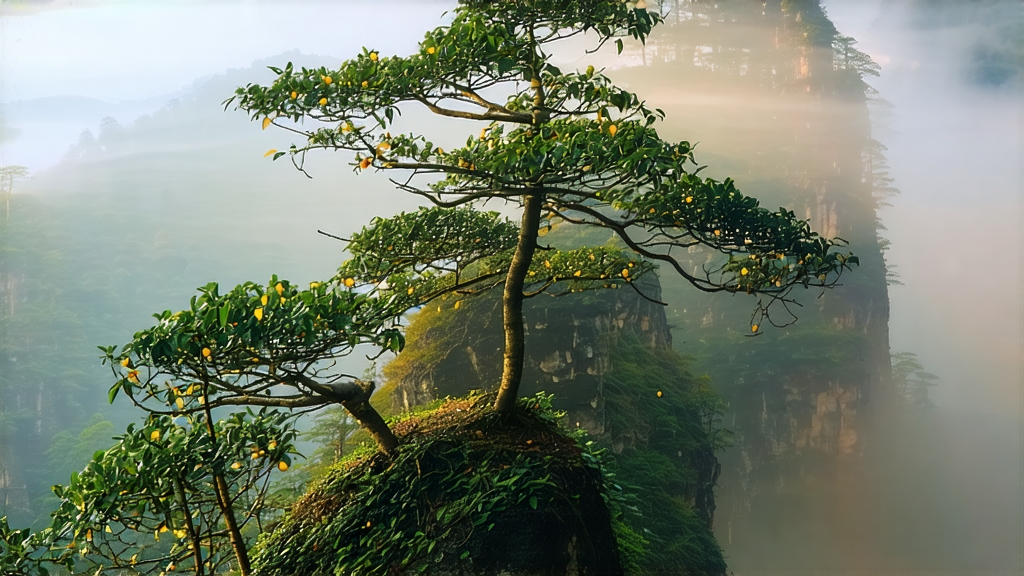
Tucked high on mist-crowned Mengding Mountain in Sichuan Province, Mengding Huangya—literally “Yellow Bud of Mengding”—is the quiet aristocrat of Chinese tea. While green, black and oolong have conquered foreign markets, this luminous yellow tea has remained a guarded secret, served only to emperors, poets and the mountain’s own clouds for more than twelve centuries. To understand Mengding Huangya is to witness a living fossil of Chinese taste, a beverage whose very colour was once reserved for the Son of Heaven.
Historical whispers
The first written record appears in the Tang dynasty (618-907) tea canon Cha Jing, where Lu Yu praises “the yellow herb of Mengding” as superior to all other buds. By the Song dynasty it had become an imperial tribute, carried by horseback and barge along the Min River to Kaifeng’s palace gates. Legend claims that the mountain’s Buddhist monks would pick the buds at dawn on the fifth day of the third lunar month, timing the harvest to the first thunderclap of spring; the tea was then locked in golden caskets and escorted by armed guards to the capital. After the fall of the Qing in 1911 the tribute system collapsed, and Mengding Huangya retreated into local memory, produced only in tiny quantities for family altars and scholarly hermits. When Chinese tea scholars “rediscovered” it in the 1950s they found fewer than a dozen old bushes surviving among wild azaleas and lichen-covered cliffs. Today the designation is protected by a geographic-origin standard that restricts authentic Mengding Huangya to peaks above 800 m within a thirty-kilometre radius of the original Mengding Temple.
Micro-terroir
Mengding Mountain is the first place in Sichuan to greet the monsoon clouds rolling off the Tibetan Plateau. The interaction between warm valley air and cool alpine drafts produces a 280-day fog season; diffused light slows photosynthesis, forcing the tea plant to stock amino acids at the expense of bitter catechins. Soils are acidic yellow loam rich in selenium and manganese, drained by countless mountain springs. The indigenous cultivar, known locally as “small-leaf yellow shoot,” keeps its buds closed longer than ordinary tea, forming a natural cocoon that protects the tender inner leaf—perfect raw material for the delicate “sealed yellowing” process that defines the category.
Plucking ritual
Authentic Mengding Huangya is made only from the single unopened bud, occasionally with half of the adjacent leaf. Picking begins when the bud reaches 15–20 mm but before the apical leaf unfurls—what farmers call “the parrot’s beak” stage. Experienced pickers can harvest barely 200 g of fresh buds per hour; 50 000 buds are needed for one liang (500 g) of finished tea. The pluck must finish before the mountain sun burns off the mist, because direct light raises leaf temperature and destroys the volatile thiazoles that later create the tea’s signature corn-silk aroma.
Crafting gold from green
Yellow tea is often mis-described as “green tea with an extra step.” In reality the process is a choreography of moisture, heat and time that borders on alchemy. Immediately after picking the buds are spread in bamboo trays and wilted for two hours under shade; this “quiet withering” reduces grassy hexanal compounds. Next comes the kill-green, but at a lower temperature (140 °C) and shorter duration (90 seconds) than green tea, leaving residual enzymes active. The critical stage is “sealed yellowing” (men huang): the warm leaf is piled in oak boxes lined with wet linen and left for 6–8 hours at 28 °C and 85 % humidity. During this interval chlorophyll degrades into pheophytin, catechins dimerise into theaflavins, and a golden pellicle forms on each bud. The process is stopped by a second low-temperature bake, then the leaf is rolled into tiny hooks and dried with charcoal embers in a wok tilted at precisely 30°. A final “awakening” rest of seven days allows residual moisture to migrate from stem to tip, rounding the flavour. The entire cycle consumes 36 hours and must be completed before the mountain night temperature drops below 12 °C, otherwise the yellowing enzymes go dormant.
Leaf anatomy and grading
Finished Mengding Huangya resembles miniature golden fish-hooks, 12–15 mm long, uniformly ochre-yellow with microscopic downy hairs that catch the light. The highest grade, “Imperial Tip